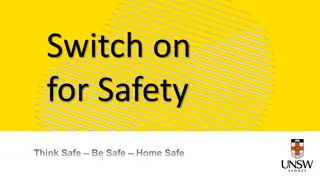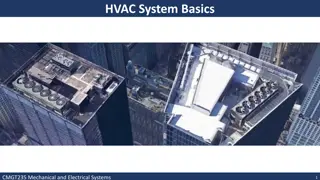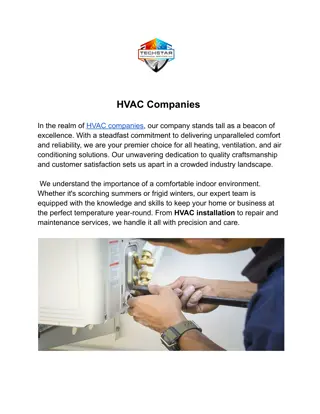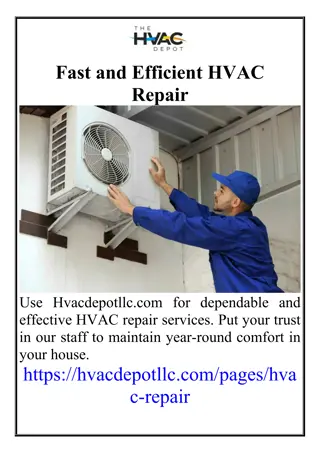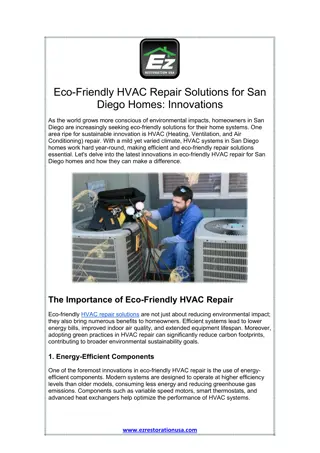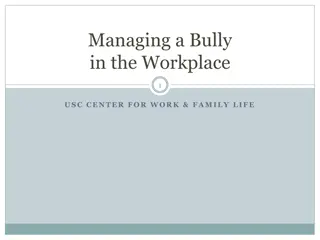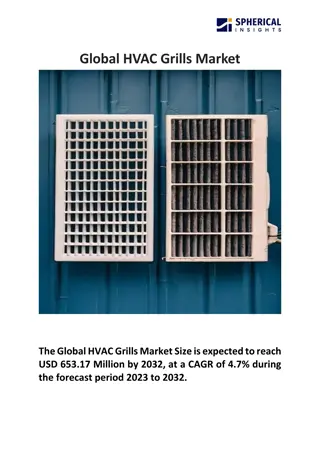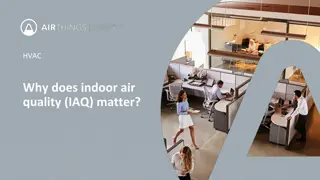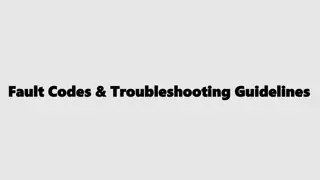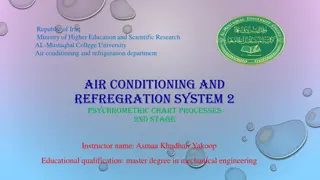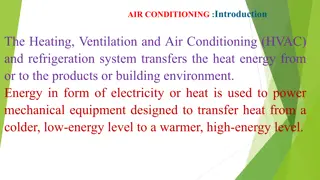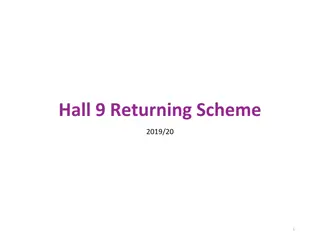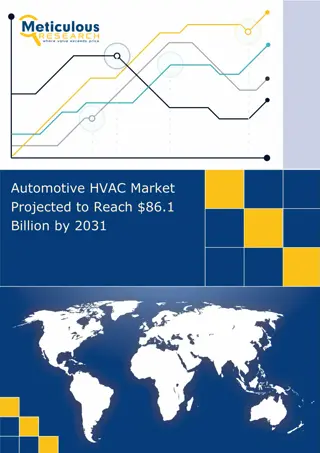HVAC Recommendations for Returning to the Workplace
CDC and ASHRAE provide recommendations for building air handling systems to address COVID-19 concerns. Key steps include inspecting systems, ensuring proper ventilation, maintaining cleanliness, using appropriate filters, and adjusting humidity levels. The response outlined preventive maintenance measures taken, filter upgrades, and humidity adjustments already in place. Strategies such as increasing ventilation per ASHRAE guidelines are also detailed for optimal workplace safety.
Download Presentation

Please find below an Image/Link to download the presentation.
The content on the website is provided AS IS for your information and personal use only. It may not be sold, licensed, or shared on other websites without obtaining consent from the author.If you encounter any issues during the download, it is possible that the publisher has removed the file from their server.
You are allowed to download the files provided on this website for personal or commercial use, subject to the condition that they are used lawfully. All files are the property of their respective owners.
The content on the website is provided AS IS for your information and personal use only. It may not be sold, licensed, or shared on other websites without obtaining consent from the author.
E N D
Presentation Transcript
COVID-19: Returning to the Workplace CDC HVAC Recommendations and Implementation
The following are recommendations for building air handling systems from CDC and ASHRAE. Inspect the air handling systems to ensure that the outside air dampers are open allowing fresh ventilation air into the building. Set the amount of ventilation air in the building to at least the ASHRAE 62.1-2019 Standard. Increase the amount of ventilation air in the building to beyond the ASHRAE 62.1-2019 Standard during periods of concern up to the maximum the HVAC system can handle. Keep the air handler cooling coils, condensate pans, and condensate traps clean and functional. Recommend Standard air filters-at Least a MERV-13: Increase the relative humidity in the building to 45-55% RH. At this humidity range 80% of the droplet nuclei viruses lose their infectivity within 15 minutes.
Our Response Inspect the air handling systems to ensure that the outside air dampers are open allowing fresh ventilation air into the building. Set the amount of ventilation air in the building to at least the ASHRAE 62.1-2019 Standard. We performed scheduled preventive maintenance on all AHU s on campus. Increase the amount of ventilation air in the building to beyond the ASHRAE 62.1-2019 Standard during periods of concern up to the maximum the HVAC system can handle. We opened all outside dampers to all AHU s in each building on campus to their max position that the HVAC system can handle. Will continue to monitor and make adjustments. Keep the air handler cooling coils, condensate pans, and condensate traps clean and functional. We performed preventive maintenance changing filters and cleaning the coils and drains as needed. Recommend Standard air filters-at Least a MERV-13 filter: All AHU have MERV-13 or higher filters. Increase the relative humidity in the building to 45-55% RH. At this humidity range 80% of the droplet nuclei viruses lose their infectivity within 15 minutes. Set-point in most buildings are already at 50%.
Increase the amount of ventilation per ASHRAE 5 Step process: I. II. Facilities Engineer (FE) team- complete the Powers programming control language (PPCL) modifications III. BP-team field verify and take measurements at AHU and VAV IV. FE/BP team- make adjustments as needed V. Monitor load Building Performance (BP) team- lead and provide a study
Minimum Building Ventilations % Rate and Relative Humidity % Set point Changes Per Building 100% 90% 80% 70% 60% 50% 40% 30% 20% 10% 0% P28 L28 V08 P18 L18 L26 V20 V23 M20 L15 P26 T36 P15 M24 R27 Building Average Current min% OA damper position Building Average Changed min% OA damper position Current Relative Humidity Setpoint Increase Relative Huminity Setpoint 29% 32% 52% 95% 95% 31% 84% 28% 71% 15% 24% 26% 91% 35% 23% 40% 45% 69% 95% 95% 52% 84% 35% 80% 30% 47% 50% 91% 50% 40% 50% 50% 50% 50% 50% 50% 50% 50% 50% 50% 50% 50% 50% 50% 50% 50%
Minimum Building Ventilations % Rate and Relative Humidity % Set point Changes Per Building 120% 100% 80% 60% 40% 20% 0% R30/R3 1 T09AK32/A P30R24/S2 U09 R09 S09 Q09 M20 L32 5 Building Average Current min% OA damper position Building Average Changed min% OA damper position Current Relative Humidity Setpoint Increase Relative Huminity Setpoint 98% 20% 12% 97% 100% 13% 14% 71% 18% 30% 99% 20% 12% 97% 100% 25% 14% 80% 18% 30%
Minimum Building Ventilations % Rate and Relative Humidity % Set point Changes Per Building 60% 50% 40% 30% 20% 10% 0% Q20-Floors B&G Q20-Floor 1 Q20-Floors 273 Q20-Floors 4&5 Q20-Floor 6&7 Q20-Floor 8 Building Average Current min% OA damper position Building Average Changed min% OA damper position Current Relative Humidity Setpoint Increase Relative Huminity Setpoint 31% 25% 20% 23% 26% 10% 52% 40% 40% 40% 40% 30%
Air Filters MERV-rating per building HVAC filters per building 16 14 12 10 8 6 4 2 0 Current MERV-Rating New MERV-Rating
Summary of Buildings HVAC Recommendations and Implementation
Summary of Recommendations and Implementation Initiative started- April 2020 Completed- November 2020 Total cost:$66,647 I. BP- 328 man hour/$16,109 labor cost/$938 material II. FE- 118 man hour/$12,000 labor III. Filter cost due to COVID-19- $22,000 IV. Purchased room air purifier- $10,000 V. Rent room air purifier- $5,600
Data/Lessons Learned BP developed a plan for re-checking and tuning dampers. Preliminary checks on some AHUs indicates they have a little higher %OA than our target number. Due to season change BP- spot checking actual %OA using the temperature method and confirming that method with airflow measurements at a few AHUs. Keep recorded data to help modify future changes Incorporate AHUs flexibility in new projects/building design.
Next Step Started- Denver campus on Dec 3rd. LSC report ready by Dec 21st. II. AB1 by Jan 8th III. School of Business by Jan 15th IV. CU by Jan 29th V. Student Wellness by Feb 12th VI. Lynx Crossing by Feb 27th I.



